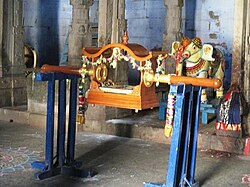As per Hindu legend, this is one of the 64 places where Shiva performed his Thiruvilayadal, the divine plays. A dancing girl named Ponanaial was a staunch devotee of Shiva and her only aim in life was to make an idol of Shiva made of gold. She was not able to accomplish due to lack of money. Pleased by her devotion, Shiva appeared in the form of metallurgist named Rasavathi who converted iron, bronze and aluminium to make the golden idol. Impressed by the beauty of the idol, Ponanaial pinched the cheeks of the idol, which is believed to be the mark in the idol.
The lingam in the temple is believed to have been self-manifested and was worshipped by Surya, Dharmaraja, Nala, Chandra, Thirasanan, Brahma and Vishnu. Since Shiva appeared under Parijatha tree, the presiding deity came to be known as Pushpaveneswarar.

Image of Marudhu brothers

Festival images of the temple
The exact year of building could not be ascertained from the inscriptions, but the stone structure of Pushpavaneswarar shrine in its current form, is built during the time of Chola king Aditya I (870 - 907 CE). The inscriptions on the two sides of the Southern shrine of the temple indicate an endowment from Aditya for perpetual lighting of lamps in the temple.
Theerthavari, the sacred bathing of the presiding deity during the auspicious days in the Tamil month of Puratasi (September - October). The temple has another inscription in the second precinct during the time of Uttama Chola (970-985 CE) for the maintenance and worship of Pushpavaneswarar and Varadaraja Perumal afforded to four able men. During the reign of Raja Raja Chola I (984-1015 CE), a village named Manali was gifted to the temple - the inscription indicates that the temple was built by Sembiyar Mahadevi.
The structure of the Vishnu shrine is believed to have expanded during the reign of Rajendra Chola I (1012-1044). It is one of the shrines of the 275 Paadal Petra Sthalams.